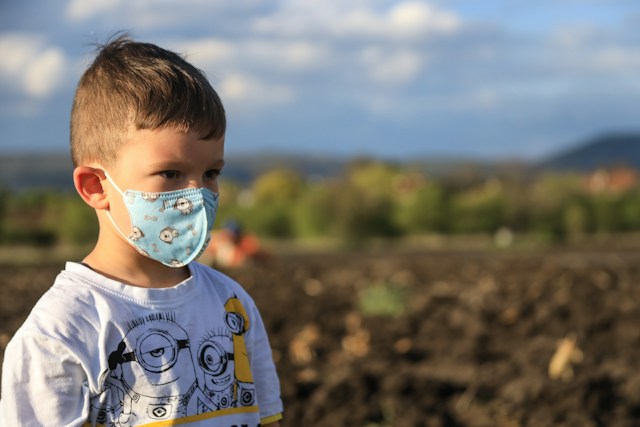Influenza, sometimes known as the flu, is a seasonal illness that causes infections of the nose, throat, and lungs. Children who have the flu frequently have symptoms including chills, a high temperature, runny or stuffy nose, cough, sore throat, exhaustion, and muscular pains. The flu poses a special risk to children because of their susceptibility to more serious side effects including pneumonia, ear infections, and worsening of pre-existing medical disorders like asthma. Young children—particularly those under the age of five—are more likely to become hospitalised from the flu and, in extreme circumstances, even pass away.

It is crucial to protect children against this viral infection by practising excellent hygiene and receiving an annual flu vaccination, as there is a danger of serious sickness and transmission to others.
To treat influenza in children, it’s critical to make sure they get enough sleep, drink lots of water, and take the prescribed over-the-counter drugs to treat symptoms like fever and congestion, as advised by a medical practitioner. Another way to stop the virus from spreading during the infectious time is to isolate yourself from other kids and adults. If a child’s symptoms worsen, he or she exhibits indications of dehydration, a persistently high temperature, or trouble breathing, parents should continuously monitor their child’s condition and seek medical treatment.
Children might have a particularly difficult time recovering from the flu, so prompt and adequate treatment is essential for their health.

Children’s Influenza Causes
Due in large part to their low levels of immunity, children are particularly susceptible to the flu. Children can contract the sickness from one another by coughing or sneezing, or by coming into close proximity at school or on the playground. Children who handle contaminated surfaces, such as sharing utensils, books, toys, and stationery, may also become infected.
Younger children who have underlying medical issues continue to have an increased risk of contracting the flu due to their weaker immune systems.
Children’s Influenza Symptoms
Within 24 hours of contracting the season flu, children will show the following symptoms:
High fever – Aches throughout the body
– Blocked nose – Severe cough – Sore throat – Overwhelming fatigue
Apart from the typical symptoms mentioned above, the kid may occasionally have extra symptoms such as vomiting, diarrhoea, and nausea.
How Can the Influenza Affect Children?
Vaccination: Getting vaccinated against influenza each year is the most reliable method of prevention. Every year, children older than six months should get the flu shot.
Children who have underlying medical issues should have immunisation especially as they are more likely to experience difficulties.
Hand hygiene: Instruct kids to always wash their hands for at least 20 seconds with soap and water, especially after using the toilet, after a cough or sneeze, and before eating.
Respiratory Hygiene: To stop the virus from spreading, teach kids to cover their mouth and nose when they cough or sneeze by covering them with a tissue or their elbow.
Refrain from Close Contact: Teach kids to stay away from unwell people. Keep your sick youngster at home to stop the illness from spreading to other people.
Good Nutrition: To strengthen their immune system, make sure your child eats a balanced diet and gets enough sleep.
Cleaning and Disinfecting: To stop the virus from spreading, routinely clean and disinfect surfaces in your house that are regularly touched.

Therapy for Influenza
Rest: In order for their bodies to heal, children who have the flu need a lot of rest. Urge them to relax and have adequate rest.
Hydration: Make sure your kid consumes enough liquids to be hydrated, including water, clear soups, and oral rehydration treatments. This aids in symptom relief and keeps you from becoming dehydrated.
Medical Evaluation: See a healthcare professional for an appropriate diagnosis and treatment plan if your kid has severe symptoms or if there are underlying medical issues.
The Distinction Between Cold and Flu
Parents frequently misinterpret or misdiagnose the symptoms of the flu and common cold. It’s fairly possible to mistake one for the other because of the similarities. The following list of differences between the common cold and the flu may help you recognise and comprehend them better:
Fever: A common cold seldom comes with a fever, and when it does, it’s usually mild. The flu, however, will show signs of a high temperature.

Headache: Headache is fairly prevalent with the flu, but unusual with a typical cold.
Sneezing: Sneezing more frequently occurs with a cold than during the flu.
Cough: Coughing is more prevalent with the flu but less common during colds.
Body pain and fatigue: less severe when cold-related, more severe when flu-related.
Conclusion:
The flu, often known as influenza, is a seasonal viral infection that can have a serious negative effect on a child’s health. Its symptoms, which include high fever, cough, sore throat, and exhaustion, can be especially difficult for young people to deal with and can result in more serious consequences like pneumonia or aggravation of other diseases. Protecting children against the flu requires preventive measures including yearly flu shots, proper cleanliness, and prompt medical intervention. It is essential to distinguish between the flu and the common cold in order to make an accurate diagnosis and provide the right treatment. We can contribute to ensuring children’s well-being and lowering the risk of serious illness and transmission to others by adopting proactive measures to prevent and treat flu in kids.
You may also like:
Polio Vaccination: What You Need To Know
Protecting Your Little One: A Look at the Most Common Childhood Illnesses & How to Deal with Them


Pingback: How to Teach Your Child Essential Mental Wellness Skills | FactsAll